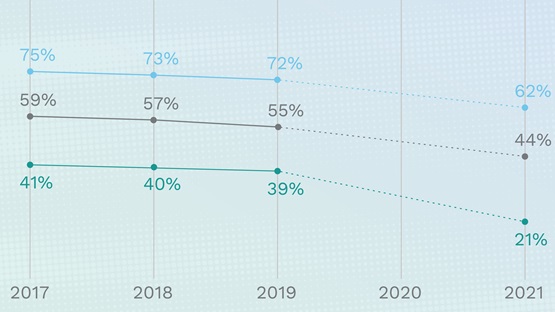Researchers at the Federal Reserve Bank of Minneapolis have documented patterns in education cases across the United States. In 2019, only about 0.16 percent of all cases reaching state appellate and Supreme Courts across the nation were related to education. 1 The vast majority of those cases relate to employment, very few are driven by state constitutional clauses, and that proportion did not significantly increase when states adopted constitutional amendments similar to the proposed Page amendment. Here are the main takeaways.
| Case type | Number of cases | Percentage of total |
|---|---|---|
| Employee - compensation, contract, or unions | 9,373 | 71.8 |
| Finance | 982 | 7.5 |
| Accountability | 899 | 6.9 |
| School choice and desegregation | 404 | 3.1 |
| Employee - other issues | 391 | 3.0 |
| Other education issues | 288 | 2.2 |
| Discipline | 233 | 1.8 |
| School system | 206 | 1.6 |
| Privacy | 167 | 1.3 |
| Discrimination | 106 | 0.8 |
| TOTAL | 13,049 | 100 |
Fact 2: Proportion of cases citing constitutional clauses is small and has remained relatively constant since 1970. 2
Source: Authors’ calculations based on cases in LexisNexis
Fact 3: There is no evidence that constitutional amendments increased litigation.
Litigation in states with amendments providing for high-quality education or education as a “paramount duty,” pre- and post-passage.
Litigation in states with amendments introducing antidiscrimination provisions and restricting affirmative action, pre- and post-passage.3
Source: Authors’ calculations based on cases in LexisNexis
Download PDF version
Endnotes
1 The patterns described in this handout are excerpts from the forthcoming paper “The Effect of Constitutional Provisions on Education Policy and Outcomes” by Scott Dallman, Anusha Nath, and Filip Premik. The views expressed herein are those of the authors and not necessarily those of the Federal Reserve Bank of Minneapolis or the Federal Reserve System. The authors thank Stephanie Chandler for invaluable feedback and Dasom Ham and Ji Sue Song for excellent research assistance.
2 A case is identified as “citing constitutional clauses” if any one of the following conditions holds: (a) the article and section numbers of education clauses of the respective state constitution are cited, (b) the equal protection clause of either the Constitution of the United States or the equal protection clauses of the state constitutions are cited, or (c) keywords related to “unconstitutional” are present.
3 While the exact wording of the antidiscrimination provisions introduced varies across states, it revolves around the following language: “shall not discriminate against, or grant preferential treatment to, any individual or group on the basis of race, sex, color, ethnicity, or national origin in the operation of public employment, public education, or public contracting.”




